Key takeaways
- Album artwork is a crucial visual representation of an artist’s identity and the emotional essence of the music.
- Effective album covers enhance the listener’s experience by creating visual narratives that resonate with the themes of the music.
- Styles and trends in album design reflect cultural movements, blending old and new to evoke nostalgia and contemporary relevance.
- Key elements of impactful artwork include color choice, image composition, typography, and alignment with the artist’s message.
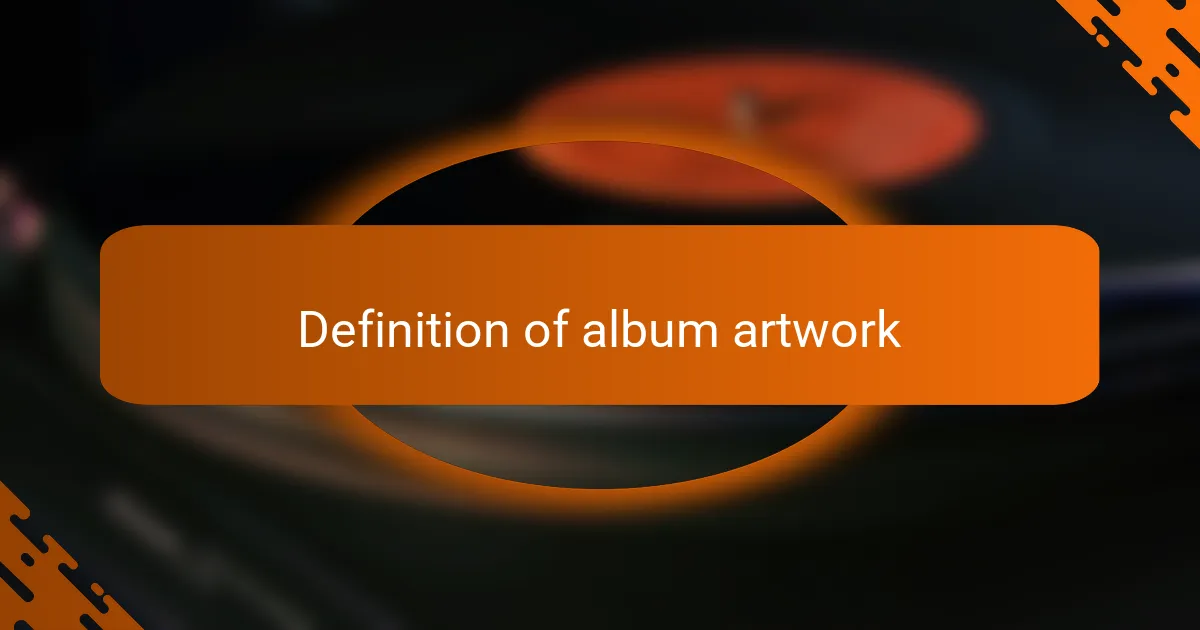
Definition of album artwork
Album artwork serves as the visual representation of a musician’s identity and creativity. It’s more than just a cover for a collection of songs; it’s a form of art that captures the essence of the music within. When I see an iconic album cover, it often stirs up emotions and memories that resonate deeply with me.
I remember the first time I saw the vibrant artwork of Pink Floyd’s “The Dark Side of the Moon.” The prism reflecting light was as striking as the music itself. This connection between sound and visuals highlights how album artwork can evoke a sense of nostalgia or inspiration. Have you ever felt that a cover perfectly encapsulated the mood of the album? I certainly have.
Moreover, album artwork often reflects the artist’s journey and artistic vision. In many cases, the imagery can hint at the themes and emotions explored in the tracks. When I think about the layered storytelling in David Bowie’s covers, I see how they complement his sonic experimentation. This interplay invites listeners to engage with the music on a more profound level, creating a multi-sensory experience.
![]()
Importance of iconic album covers
The significance of iconic album covers can’t be overstated. They serve as a visual representation of the music contained within, often setting the tone and inviting listeners into the artist’s world. I remember the excitement I felt flipping through vinyl records and stopping dead in my tracks at the sheer beauty of the “Dark Side of the Moon” cover. It wasn’t just a cover; it was an invitation to explore something profound.
Album artwork can ignite curiosity and create a connection to the music itself. It’s fascinating how a single image can evoke powerful emotions or memories tied to the songs. For instance, the raw imagery of Nirvana’s “Nevermind” immediately transports me back to my teenage years, filled with angst and discovery.
- They capture the essence of the music and artist’s vision.
- An iconic cover can transcend generations, becoming a piece of art on its own.
- Artwork creates visual narratives that complement the sound, enhancing the listener’s experience.
- Memorable designs often stick in the cultural consciousness, making them instantly recognizable.
- A strong album cover can influence first impressions, sometimes drawing in an audience that might not otherwise engage with the music.
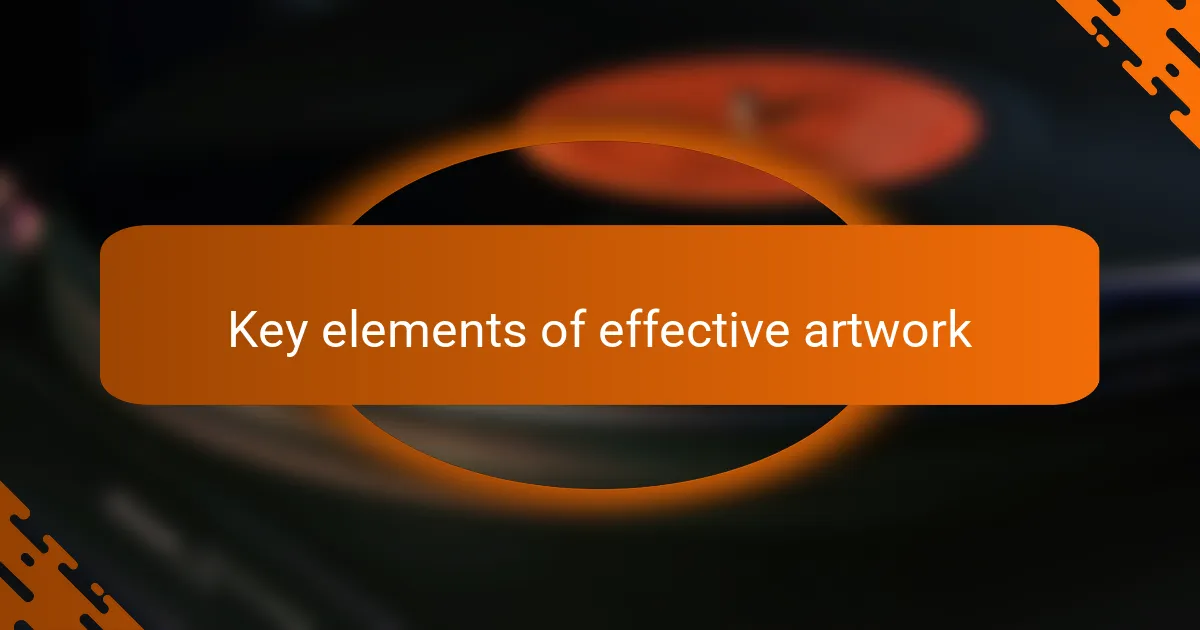
Key elements of effective artwork
When I think about the elements that make album artwork truly effective, I often consider the emotional connection it fosters. Effective artwork captures not just the essence of the music but also the feelings it evokes. For instance, an album cover can immediately draw us in, making us feel nostalgia or excitement before the first note even plays.
Color choice, image composition, and typography are pivotal in this regard. I remember the first time I saw the cover art for Pink Floyd’s “The Dark Side of the Moon.” The prism reflected on a black background wasn’t just a cover; it symbolized the depth and complexity of the album’s themes. Artwork like this can leave a lasting impression and serve as a visual representation of the music itself.
Another key element is how the artwork aligns with the artist’s identity or message. I often think about how the cover art for Adele’s “21” captures her soulful essence and relatability. It’s a beautiful juxtaposition of simplicity and sophistication, much like her voice.
| Key Element | Description |
|---|---|
| Color Choice | Sets the emotional tone and attracts attention. |
| Image Composition | Arranges visual elements to create a narrative or evoke feelings. |
| Typography | Typography effectively conveys the artist’s style and enhances the artwork’s impact. |
| Alignment with Artist Identity | Reflects the artist’s message or persona, fostering a deeper connection with the audience. |
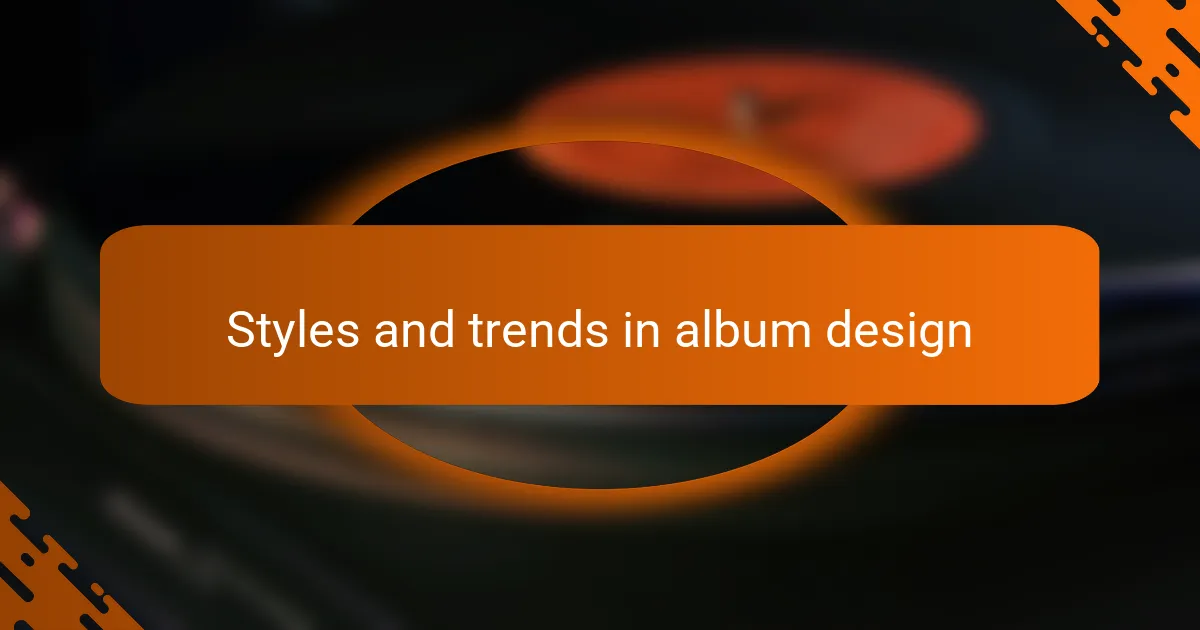
Styles and trends in album design
When I think about styles and trends in album design, it’s fascinating how they reflect the cultural and artistic movements of their time. For instance, the vibrant colors and surreal imagery of the 1960s psychedelia, seen in albums like The Beatles’ “Sgt. Pepper’s Lonely Hearts Club Band,” transported listeners into a new realm of creativity. Similarly, modern minimalist designs, like those of Taylor Swift’s “Folklore,” evoke feelings of intimacy and personal storytelling, which resonate deeply with fans today.
I’ve noticed that some artists intentionally channel previous styles while adding their unique twist, creating a beautiful blend of old and new. This interplay of inspiration can evoke nostalgia while ensuring relevance in today’s music landscape.
Here’s a quick comparison of various album artwork styles and trends:
| Style/Trend | Characteristics |
|---|---|
| Psychedelia | Vibrant colors, surreal themes, intricate illustrations |
| Minimalism | Simple designs, limited color palette, focuses on typography |
| Collage | Mixed media, layering of images, expressed themes through contrast |
| Photography | Realistic imagery capturing artist’s essence, often personal storytelling |

Personal favorites in album artwork
One of my absolute favorites is the cover of “Abbey Road” by The Beatles. The iconic image of the band crossing the street is not just a snapshot; it feels like a moment in time that captures the essence of the 1960s. Every time I see it, I can’t help but wonder what those four gentlemen were thinking as they strolled across that zebra crossing, a symbol of their journey through music and life.
Another personal favorite is the stark black-and-white cover of The White Stripes’ “Elephant.” The simplicity of the design contrasts beautifully with the energy of the music inside. It makes me feel as if I’m about to embark on an exhilarating ride, reflecting the raw spirit of rock ‘n’ roll. Have you ever found yourself drawn to an album simply because its cover promised something special? That’s how I feel about this one.
Then there’s Björk’s “Post,” which stands out with its vibrant, eclectic collage that mirrors her innovative sound. Every detail seems to tell a story, creating a rich tapestry of emotions and experiences. Whenever I look at it, I’m reminded of how music and visuals can intertwine, sparking imagination and connection. This interplay makes album artwork a powerful form of expression.
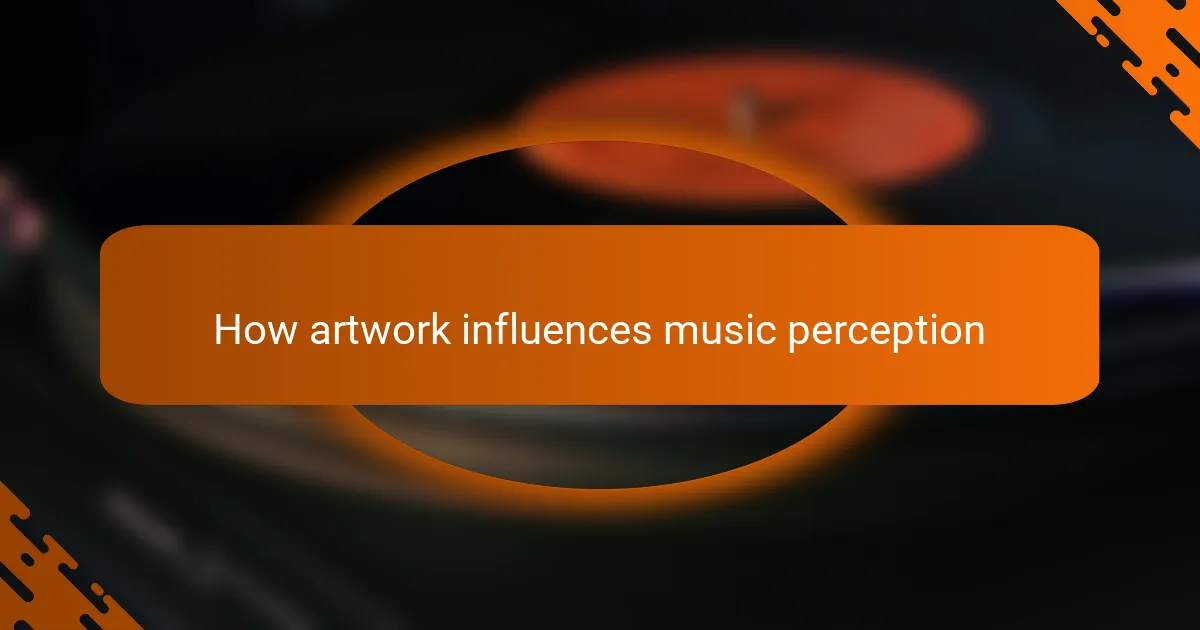
How artwork influences music perception
The experience of discovering music often starts with the artwork. A striking album cover can pique my interest and draw me in, even before I hear the first note. For example, I vividly remember how the bold colors and surreal imagery of Tame Impala’s “Currents” instantly caught my eye. It set a dreamy mood that perfectly complemented the album’s sound, making it feel like a visual gateway into a new auditory world.
I’ve noticed that album artwork can evoke specific feelings that resonate with our personal experiences. With Fleetwood Mac’s “Rumours,” the cover’s simplicity and elegance mirror the raw emotions found in the music. It often makes me reflect on love and heartbreak, influencing my perception of the album each time I revisit it. Have you ever felt that the artwork not only represents the music but actually enhances your emotional connection to it? I certainly have.
Moreover, iconic album covers often linger in cultural memory, morphing into symbols that signify entire eras. Take Nirvana’s “Nevermind,” for instance—its bold imagery stirred conversations about youth culture and rebellion. Each time I see that cover, it transports me back to that moment of angst and discovery in my life. There’s a palpable energy in these visuals that shapes how we remember, engage with, and ultimately relate to the music. It’s remarkable how something as seemingly simple as an image can hold so much power over our perceptions.
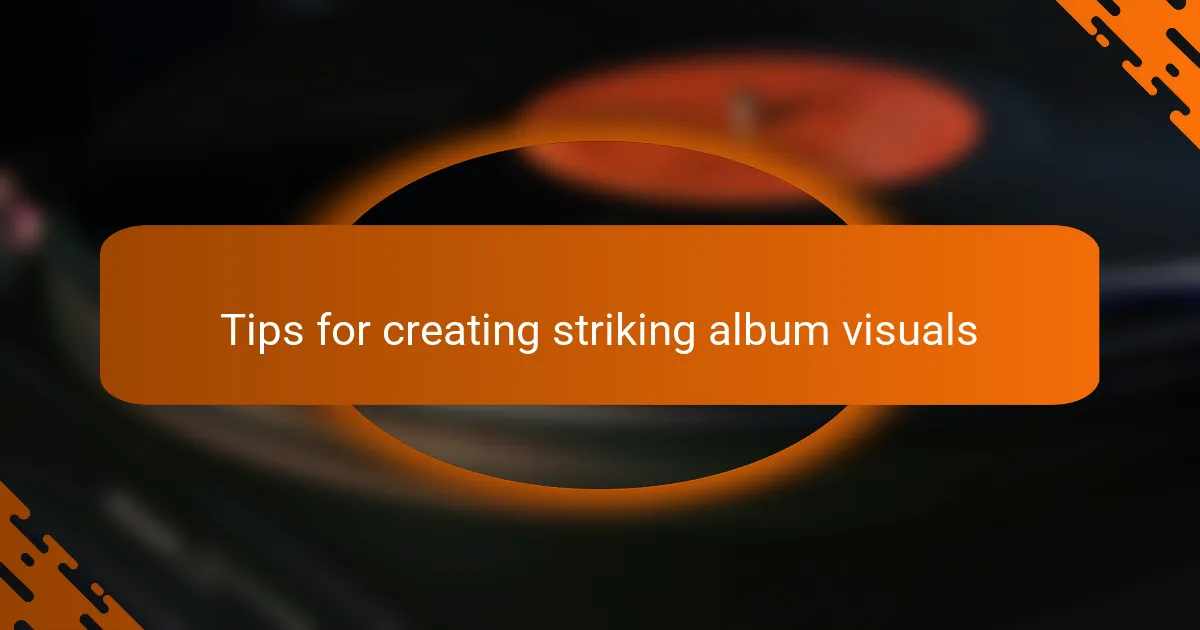
Tips for creating striking album visuals
Creating striking album visuals is a blend of artistic vision and emotional depth. Color choice plays a crucial role; vibrant hues can evoke feelings of joy or energy, while darker tones may provoke introspective thoughts. For me, the vivid reds and blues of Jimi Hendrix’s “Axis: Bold as Love” not only reflect his experimental sound but also immerse me in the psychedelic journey he intended.
When designing album art, maintaining a strong relationship between the imagery and the artist’s message is essential. I often reflect on how the stark imagery of Nine Inch Nails’ “The Downward Spiral” perfectly aligns with its themes of struggle and despair. Every time I see that cover, it deepens my understanding of the album’s emotional landscape, prompting me to engage with the music on a more meaningful level. Have you noticed how certain images resonate long after you’ve seen them?
Lastly, don’t underestimate the power of typography in your artwork. The font you choose can convey so much about the artist’s style and genre. For instance, the elegant script on Norah Jones’ “Come Away With Me” suggests warmth and soulful storytelling, drawing me in immediately. Thinking about your type choice, how can it enhance the story your music tells? It’s a detail that can make a significant difference in the overall visual impact.